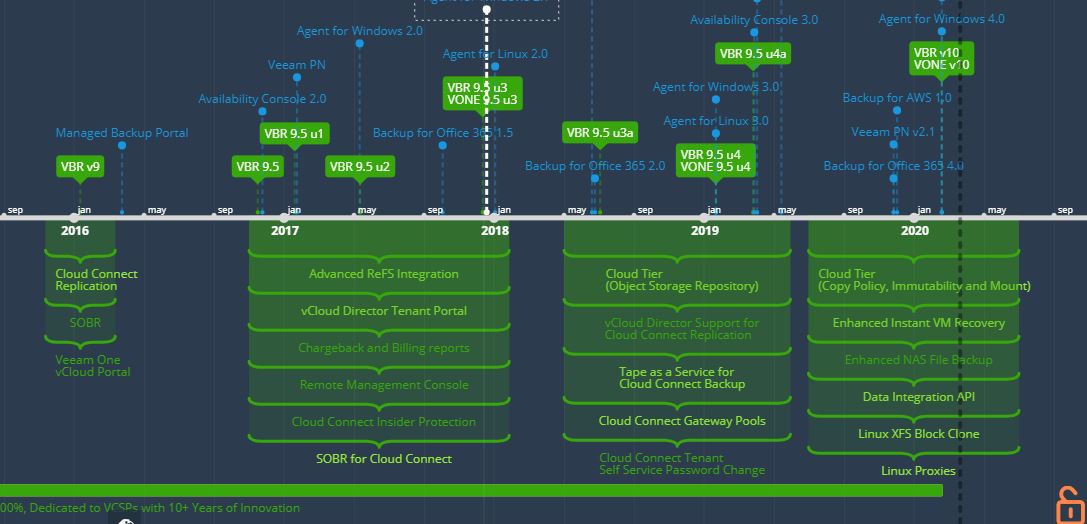When Veeam launched its first release of Veeam Backup & Replication in 2008, it was a powerful and easy-to-use backup application that revolutionised virtual server backup.
According to Senior Global Technologist, Product Strategy at Veeam Software, Anthony Spiteri, within a few years, and with forward-thinking innovations introduced in each release, Veeam Backup & Replication became the leader in the industry.
Over a decade later, this feature has evolved to become the Veeam Availability Suite v10, or simply Veeam V10, a comprehensive suite that aims to empower organisations with advanced capabilities and powerful tools to achieve goals of 100-percent data protection with High Availability and reduced downtime.
In recent releases of Veeam Availability Suite (VAS), the ability to centrally manage physical server and cloud-based workloads using Veeam agents have also been added. This extends virtual backup software to both physical and cloud workloads.
What that means is portability and mobility of data allowing customers the ability to backup workloads from any device, be it physical, virtual or in the cloud and then have that data be recovered to any platform.”
Enterprise IT News has an email chat with Anthony to find out what Veeam’s backup and replication technology has been up to since 2008.
EITN: What else did you offer in 2008 besides backup and replication? The reason I ask is to understand what other capabilities from 2008 have been integrated into v10, if any?
Anthony: Besides backup and replication, Veeam also offers services in monitoring and analytics, orchestration and universal storage APIs. Over the years, we have added in capabilities such as Instant VM Recovery which was an industry first, more cloud-based features that our Cloud and Service Providers can take advantage of and more recently, tapping into the service offerings of the Public Cloud Hyper-Scalers to offer solutions to further protect data offsite and onto longer term storage like Object Storage.
If you think of it like an onion, Veeam continues to add layers to the base Backup & Replication product. We were the first to release both backup and replication in the same product and even today that isn’t a default in the industry.
In terms of capabilities that were present in 2008 and in v10, most of the core backup and replication engine still exists and had been iterated on and improved on in every release. As we add more features and enhancements we extend the value of the core product and keep things innovative for our customers.
EITN: What are the top 3 business objectives that organisations want to meet when they deploy Veeam’s availability solutions?
Anthony: The top 3 business objectives are data availability, data agility and business acceleration. With v10, users will have:
- Data availability – simple, flexible and reliable backup and recovery of all applications and data, on premises or in the cloud
- Data agility – portable data to unlock greater potential for innovation. They can also leverage on environments without constraints on data mobility
- Business acceleration – Ability to reuse of data drives efficiencies and leverage existing backup data to pursue new opportunities without increasing cost
EITN: Why is v10 the biggest release in the history of Veeam? What are the top enhancements you have made?
Anthony: The v10 of Veeam’s Availability Suite was built on a decade of experience in data management and now supports mass recovery of virtual machines in less than five minutes regardless of size. The top enhancements of v10 include better backup, faster recovery and smarter data.
Better backup
NAS backup is now redefined, allowing data protection for massive file data. V10 also allows users to easily meet backup objectives with supercharged SAP and Oracle backups with parallel backup stream processing. Besides that, they can extend scalability while ensuring Linux-based databases such as MySQL and PostgreSQL are protected and deliver zero impact snapshot protection.
Faster recovery
Data recovery is accelerated with next-gen Instant recovery engine by simplifying mass recovery and having a flexible Oracle recovery. Now, users can instantly recover multiple VMs to simplify migration or multi-part application recovery with ease. They are also able to go beyond the traditional RMAN recovery with flexibility to publish, export or redirect their Oracle database.
Smarter data
With v10, data stays safe. Users are able to fully protect their backup copies with S3 object lock, thanks to 100% ransomware-proof backup copies. Enhancements have also been made to Nutanix AHV workloads, allowing further integration to protect them. Backup copies can now be used for data mining and security analysis with enhanced APIs, allowing users to use storage in smart new ways.
EITN: Please share how v10 would be able to protect against ransomware, insider threats and malicious admins.
Anthony: Customers will be able to prevent ransomware, malware and threats by making backup copies immutable, ensuring that backup copies in object storage are not only recoverable, but also prevent backup copies from being deleted or modified.
With v10, they will also be able to take advantage of capabilities including:
- Secure data with air-gapped backups through S3 object lock integration that protects against malware and malicious actors
- Data management that’s made easy through automated, immutable backup copies
- Avoid customer data breaches associated with ransomware and malware








